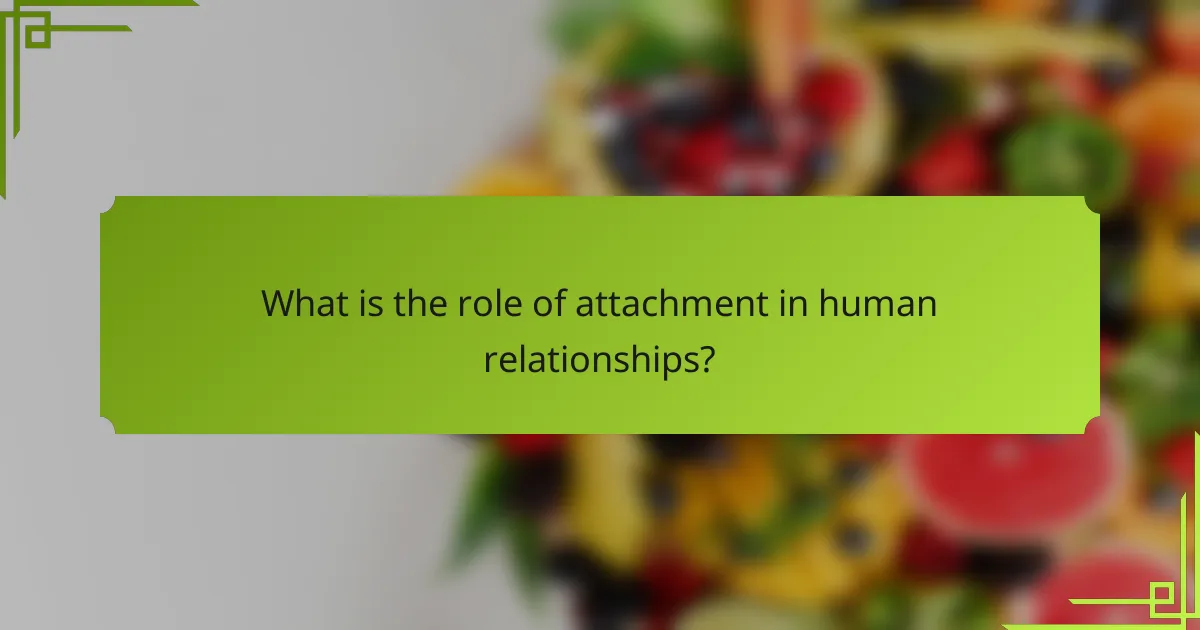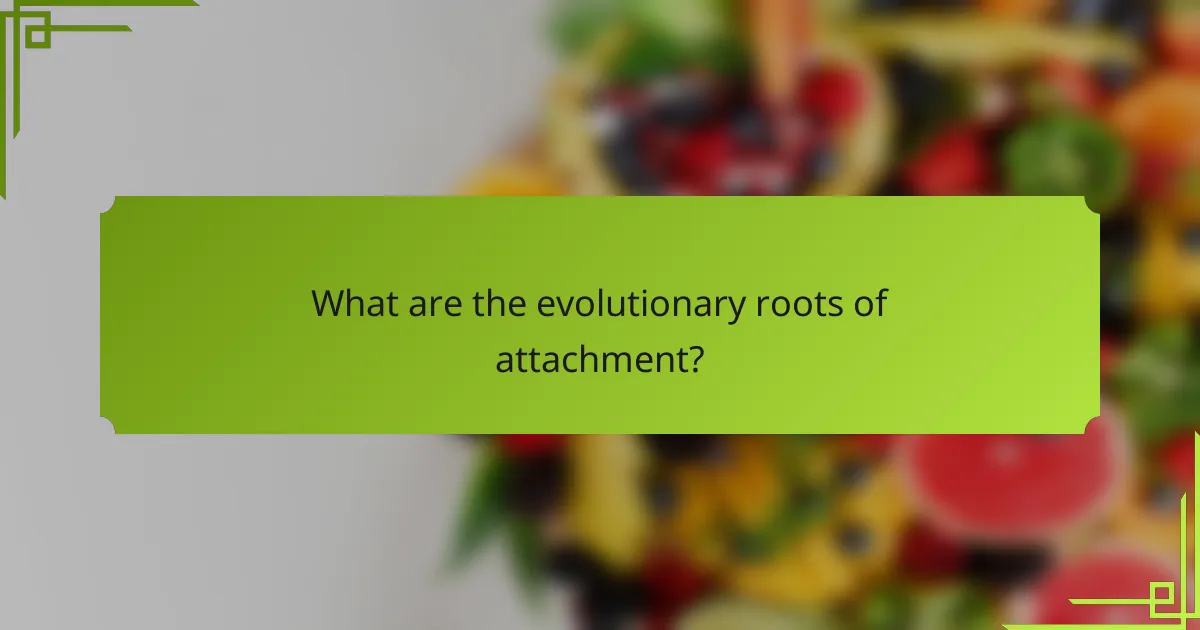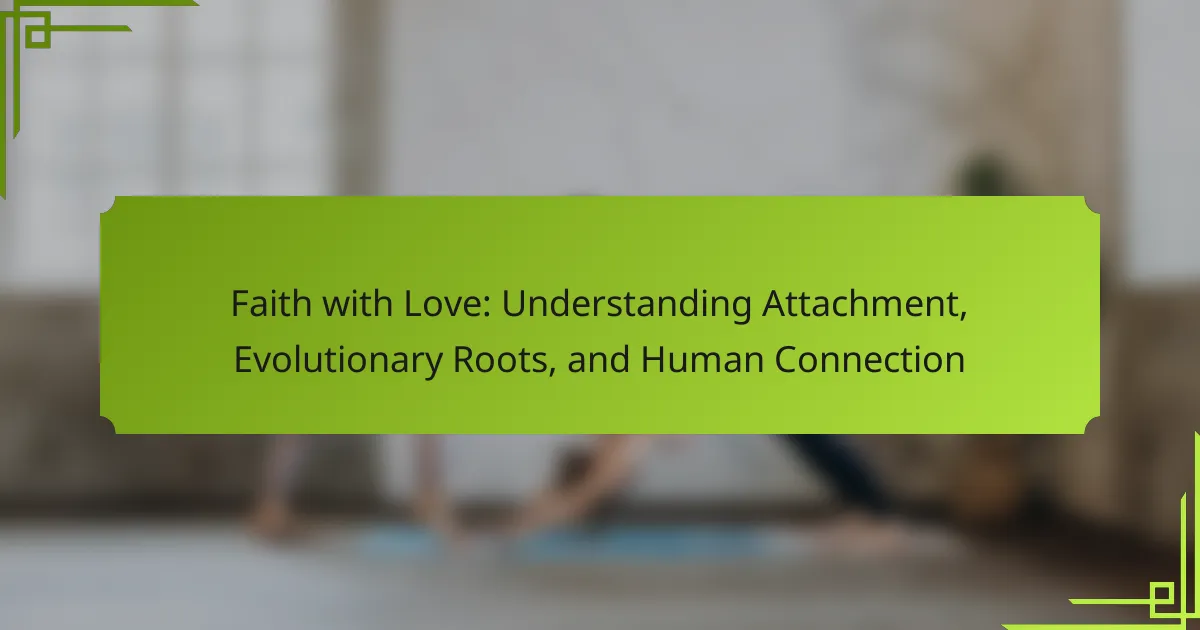Understanding attachment is vital for fostering healthy relationships and emotional well-being. This article explores the role of attachment in human connection, its evolutionary roots, and how love influences attachment dynamics. It also examines rare attributes that impact these relationships and offers strategies for fostering secure attachments. By recognizing these patterns, individuals can enhance trust, intimacy, and relational satisfaction.

What is the role of attachment in human relationships?
Attachment plays a crucial role in human relationships by fostering emotional bonds and providing security. It influences how individuals connect, communicate, and respond to one another. Attachment styles, shaped by early experiences, impact relationship dynamics, trust, and intimacy. Secure attachment promotes healthy interactions, while insecure styles can lead to challenges in forming lasting connections. Understanding these patterns enhances personal growth and relational satisfaction.
How does attachment theory explain emotional bonds?
Attachment theory explains emotional bonds as a fundamental aspect of human relationships, rooted in evolutionary survival mechanisms. This theory posits that secure attachments foster trust and intimacy, enhancing emotional well-being. Individuals with strong emotional bonds exhibit higher resilience and better coping strategies. Attachment styles, formed in early life, influence adult relationships, affecting how love and support are perceived and expressed. Understanding these dynamics can enhance personal connections and promote healthier interactions.
What are the different attachment styles?
There are four primary attachment styles: secure, anxious, avoidant, and disorganized. Each style reflects different patterns of behavior in relationships and emotional responses. Secure attachment fosters healthy connections, while anxious and avoidant styles can lead to challenges in intimacy. Disorganized attachment often results from trauma and creates confusion in relationships. Understanding these styles can enhance interpersonal dynamics and emotional health.
How do secure, anxious, and avoidant styles manifest?
Secure, anxious, and avoidant attachment styles manifest through distinct behaviors and emotional responses in relationships. Secure individuals exhibit trust and effective communication, fostering healthy connections. Anxious individuals often seek reassurance and may display clinginess, driven by fear of abandonment. Avoidant individuals tend to distance themselves, prioritizing independence over intimacy, which can lead to emotional disengagement. Understanding these styles enhances awareness of relational dynamics and promotes healthier interactions.
What evolutionary advantages do attachments provide?
Attachments provide evolutionary advantages by fostering social bonds, enhancing cooperation, and ensuring survival through protection and resource sharing. These connections improve emotional well-being and increase the likelihood of successful reproduction. Secure attachments promote group cohesion, which is vital for facing environmental challenges. The unique attribute of emotional security derived from attachments significantly contributes to individual resilience and adaptive behavior in social contexts.

What are the evolutionary roots of attachment?
Attachment has evolutionary roots that enhance survival and social bonding. Early humans developed attachment behaviors to ensure care and protection from caregivers. These behaviors fostered group cohesion, increasing chances of survival in hostile environments. Secure attachment promotes trust and emotional support, which are vital for successful human relationships. Research shows that attachment styles influence interpersonal connections throughout life, impacting mental health and social functioning. Understanding these evolutionary roots helps clarify the significance of attachment in human connection and emotional well-being.
How did early human social structures influence attachment?
Early human social structures significantly shaped attachment by fostering cooperation and emotional bonds. These structures emphasized communal living, which enhanced survival through shared resources and support. The need for secure attachments facilitated social cohesion, promoting trust and collaboration within groups. This unique attribute of interdependence laid the foundation for complex emotional connections, influencing human relationships throughout evolution. As a result, attachment styles developed, reflecting the dynamics of early social interactions and their impact on individual well-being.
What is the connection between attachment and survival in ancestral environments?
Attachment is crucial for survival in ancestral environments, fostering social bonds and cooperation. Strong attachments ensured caregiving and protection, increasing offspring survival rates. Evolution favored individuals with secure attachments, leading to enhanced social networks and resource sharing. This connection between attachment and survival highlights the importance of emotional ties in human evolution.

How does love influence attachment in relationships?
Love significantly influences attachment in relationships by fostering emotional bonds and security. This connection stems from evolutionary roots, where attachment promotes survival through social cooperation. Research shows that secure attachment leads to healthier relationships, enhancing trust and intimacy. Understanding these dynamics can strengthen human connections and improve relational satisfaction.
What psychological mechanisms underlie love and attachment?
Psychological mechanisms of love and attachment are rooted in evolutionary biology and social bonding. These mechanisms include attachment theory, which explains how emotional bonds form through proximity and caregiving. Oxytocin, known as the “love hormone,” plays a significant role in strengthening attachments. Additionally, the concepts of secure and insecure attachments influence relationship dynamics. Understanding these mechanisms reveals the complexity of human connections and their evolutionary significance.
How do cultural differences shape expressions of love and attachment?
Cultural differences significantly influence expressions of love and attachment. These variations manifest through communication styles, familial expectations, and societal norms. For instance, collectivist cultures often prioritize familial bonds and community, while individualistic cultures emphasize personal choice and romantic love. Research indicates that attachment styles, shaped by cultural context, affect relationship dynamics and emotional expression. Understanding these nuances fosters deeper human connections across diverse backgrounds.

What unique attributes define faith in love?
Faith in love is defined by trust, commitment, and emotional security. These unique attributes foster deep connections, influencing relationship dynamics. Trust allows partners to rely on each other, while commitment strengthens bonds over time. Emotional security promotes vulnerability, enhancing intimacy and understanding. Together, these elements create a resilient foundation for lasting love.
How does faith enhance emotional resilience in relationships?
Faith enhances emotional resilience in relationships by fostering trust, promoting forgiveness, and encouraging empathy. This foundation helps individuals navigate challenges together, reinforcing their bond. Faith often provides a shared purpose, strengthening connection and understanding. Additionally, it can offer comfort during difficult times, contributing to emotional stability.
What are the psychological benefits of believing in love?
Believing in love offers significant psychological benefits, including enhanced emotional resilience, improved mental health, and stronger social connections. Individuals who embrace love often experience reduced anxiety and depression, leading to greater life satisfaction.
Research shows that love activates brain regions associated with pleasure and reward, fostering feelings of happiness and fulfillment. This emotional boost can enhance overall well-being and promote a positive outlook on life.
Furthermore, believing in love strengthens interpersonal relationships, encouraging trust and intimacy. These connections provide essential support systems, contributing to decreased feelings of loneliness and isolation.
Ultimately, faith in love nurtures a sense of belonging and purpose, reinforcing the evolutionary roots of human connection. This belief can lead to a more meaningful life, enhancing both individual and collective experiences.

What rare attributes can impact attachment dynamics?
Rare attributes that can impact attachment dynamics include individual attachment styles, early childhood experiences, and cultural influences. These factors shape how love is expressed and perceived. For example, a secure attachment style often leads to healthier relationships, while an anxious style may create dependency. Early experiences with caregivers can foster trust or fear, influencing future connections. Additionally, cultural norms dictate expressions of love and attachment, affecting relationship dynamics across different societies. Understanding these rare attributes can enhance awareness of one’s attachment patterns and improve interpersonal relationships.
How do traumatic experiences alter attachment styles?
Traumatic experiences can significantly alter attachment styles, often leading to insecure attachments. These changes occur due to the impact of trauma on emotional regulation and trust in relationships. Individuals may develop anxious, avoidant, or disorganized attachment styles as a result of their experiences. For example, someone who has faced betrayal may become overly clingy or distant, reflecting their struggles with trust. Understanding these shifts is crucial for fostering healing and improving relationships.
What role does neurobiology play in attachment and love?
Neurobiology plays a crucial role in attachment and love by influencing emotional bonding and social behavior. The brain’s reward system, including the release of oxytocin and dopamine, fosters feelings of connection and pleasure. These neurochemical processes are rooted in evolutionary biology, promoting survival through social cooperation and nurturing. Understanding these mechanisms highlights the biological underpinnings of human connection and attachment styles.

What are the best practices for fostering healthy attachments?
Fostering healthy attachments involves consistent communication, emotional support, and mutual respect. Establish trust through reliability and openness. Encourage shared experiences to strengthen connections. Recognize and validate each other’s feelings, promoting emotional safety. Prioritize quality time together, enhancing intimacy and understanding.
How can individuals strengthen their attachment styles?
Individuals can strengthen their attachment styles by cultivating self-awareness, improving communication, and fostering emotional intimacy. Engaging in reflective practices helps identify attachment patterns. Open conversations with partners enhance understanding and trust. Building emotional connections through shared experiences deepens bonds. As a result, these strategies promote healthier relationships and secure attachment styles.
What common mistakes hinder attachment development?
Common mistakes that hinder attachment development include lack of emotional availability, inconsistent responses, and poor communication. These behaviors disrupt trust and create insecurity in relationships. Additionally, neglecting to prioritize quality time together can weaken bonds. Recognizing these pitfalls is crucial for fostering healthy connections.
How can understanding evolutionary psychology improve relationships?
Understanding evolutionary psychology enhances relationships by revealing innate behaviors and attachment styles. Recognizing these patterns fosters empathy and communication, promoting stronger connections. For example, understanding the evolutionary basis of attachment can guide partners in addressing insecurities and improving intimacy. This insight leads to healthier interactions, as individuals learn to navigate emotional needs rooted in their evolutionary history.
